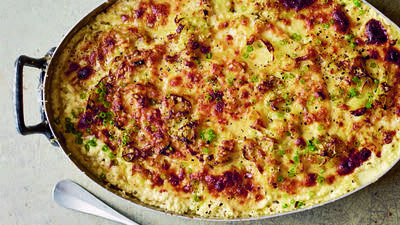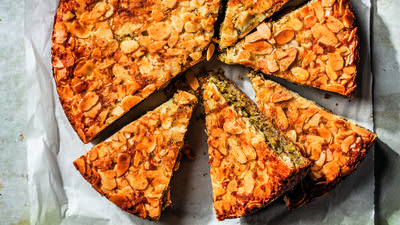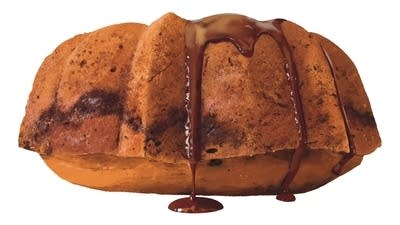
Mourad Lahlou came to America from Morocco, not to work in restaurants, but to study economics, until he missed the taste of his food so much that he decided to become a chef. And in his restaurants, he makes beautiful versions of Moroccan food – like traditional hand-rolled couscous and modern, jet-black aerated smoked eggplant purees. Now, he and his chef Louis Maldonado are opening a new restaurant called Amara, where the food is a mix of Moroccan and Mexican flavors – two cuisines with more in common that you might think.
Francis Lam: To be honest, if someone said to me – out of the blue – “Let's go check out this new Moroccan Mexican restaurant,” I would have been, like, “Say, what?” That's kind of bananas.
Mourad Lahlou: Exactly.
 Chef Mourad Lahlou
(Courtesy: Mourad Lahlou)
Chef Mourad Lahlou
(Courtesy: Mourad Lahlou)
FL: But you don't think it sounds bananas.
ML: Not at all. I mean, when we first started talking about this project, it did not come about because we were trying to do something gimmicky or cute. This whole thing started even before Louis came to work with me at Aziza, where I was working with my staff in the kitchen, and they were all from Guatemala and from the Yucatán. When we would make stuff that was extremely traditional Moroccan, they would have absolutely no problem recognizing the flavors, the spices, even the technique. It was really a seamless kind of thing that we were watching day in and day out. And that's where the connection started. But, it was reinforced when Louis started working with me and we were able to intellectually discuss these things and get to the bottom of it.
FL: What have you found, Louis?
Louis Maldonado: Just conceiving dishes. From my standpoint, looking at it from the outside, it was just seeing the similarities between both cuisines. I see the food and everything else as an American and from the Western standpoint. I don't necessarily know the traditional stuff. I'm seeing it from the Moroccan lens and then as I'm studying Mexican cuisine, it's doing the influences with that.
FL: What are some of the combinations and commonalities between the cuisines that you've found and that you want to work with?
ML: As you said at the beginning, if you told somebody, “We're going to mix Mexican food and Moorish food” – it sounds silly. But the more you look into it, the more you see that there's a huge connection between how it happened when the Moors invaded Southern Europe. Basically, in 711 they invaded Spain and Portugal and they sat up there for about 800 years. The influence of the Moors with all the spices, cuisine, architecture, music, everything was literally put in place in Spain and in Portugal.
Surprisingly enough, the same year they were kicked out of Spain, that's the same year that Christopher Columbus discovered America, and he brought with him a lot of the Moors that were captive. When the Moors were defeated, some of them were enslaved and brought to the New World to work and to cultivate the ground and farm and do all these things that needed to be done.
The connection is there, and you can see it in the food in Mexico. You can see it even today. One of the examples that I can think of is there's a dish in Mexico called Moros y Cristianos – the Moors and the Christians; it's a dish that has rice and black beans.
FL: White rice and black beans.
ML: Yes. The rice was brought in by the Spanish. The Spanish got it from the Moors. And obviously the black bean is something that was cultivated in Latin America. They put together this dish that is simple, beautiful, and tasty. It exemplifies the two cultures together.
FL: It’s funny, too, because one of my favorite tacos is tacos al pastor. And if you look at the way they make it, it's a trompo. Basically, it's a rotating rotisserie of all these slices of pork that are stacked into this cone of meat that they roast in a rotisserie and keep slicing off. It's delicious and it looks exactly like shwarma.
ML: Dude, it's a gyro!
FL: Yeah, it's a gyro, right?
ML: There's no doubt about it. It happens exactly when the Spanish go to the New World. It’s the idea of roasting meat that is stacked up in a vertical manner. It’s totally Middle Eastern. And to put it on a tortilla, instead of the pita, and it has the yogurt sauce; you know it's a gyro!
 Chef Louis Maldonado
Photo: Spoonbar
Chef Louis Maldonado
Photo: Spoonbar
FL: I think that happened more with Lebanese immigrants into Mexico, but there are so many flavor similarities that connect.
As you explore the menu you want to do in this new restaurant, what are some of the flavors that you want to play with? What are some of the things that you think will be important in your cooking?
ML: As you said, al pastor is something that is unique and very well known – it’s famous. We're going take it a step back and do our own interpretations of what it means when it first happened. We will go back and examine the dish, dissect it, and understand it, to try to come up with a version of it that makes sense to us. Louis, what do you think?
LM: In the case of developing the new dishes, it's also looking at either classic Mexican or classic Moroccan dishes and trying to compare the two. If you look at your classic mole it’s going to have nuts or seeds, it's going to have some sort of dried fruit component, obviously the chilies. And then you'd look back at Moroccan cuisine with the dried fruit, the nuts, and then put the two together. We're writing it as we go, but the flavors between the two always work well together.
ML: I do believe that one of the things that Moroccan food does better than most cuisines is marrying the sweet and the savory. The first time I heard of mole and I tasted it, it reminded me a lot of Moroccan food. They were able to take something sweet with something that is savory and combine it into an iconic dish. That was a light bulb moment to me, and I realized that there were so many similarities between the two cuisines.
FL: As you're experimenting right now and you're looking into your research and getting inspired, what are you playing with? What will we taste if we were to walk into your test kitchen today?
LM: Right now it's defining what our mole's going to be. I mean, we have to have a mole. So, right now we're working on an assortment of chilies, we're infusing the steeping water with rose, prunes, preserved lemon so you get the undertones of it. But at the end of the day, you get the sesame seed, the pomegranate molasses, pumpkin seeds, the burnt onions and garlic. We’re really trying to write it as we go. But the mole, as the first one, is to bring the two together.
FL: This is fascinating. I can't wait to see what you guys come up with.
ML: We look forward to having you.
Mourad Lahlou is the chef-owner of Mourad restaurant in San Francisco, and Louis Maldonado will lead the kitchen of the soon-to-open restaurant, Amara. If all their talk with Francis about tacos al pastor made you hungry, try this recipe for tacos al pastor (with related recipes for abobo, salsa rojo and faw salsa verde) from Alex Stupak and Jordana Rothman.
Before you go...
Each week, The Splendid Table brings you stories that expand your world view, inspire you to try something new, and show how food connects us all. We rely on your generous support. For as little as $5 a month, you can have a lasting impact on The Splendid Table. And, when you donate, you’ll join a community of like-minded individuals who love good food, good conversation, and kitchen companionship. Show your love for The Splendid Table with a gift today.
Thank you for your support.
Donate today for as little as $5.00 a month. Your gift only takes a few minutes and has a lasting impact on The Splendid Table and you'll be welcomed into The Splendid Table Co-op.




